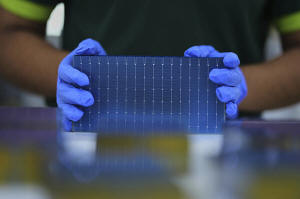India’s solar industry, aiming to compete with China, finds strength as
US tariffs hit home
[September 05, 2025] By
PIYUSH NAGPAL and SIBI ARASU
JAIPUR, India (AP) — On the edge of Jaipur, an Indian city known for its
colorful bazaars and palaces, a bustling industrial complex is the
epicenter of the country's push to compete with China in making
components for solar technology.
India, the world's most populous nation, is jockeying for market share
against the global leader in solar in part by selling to its own
citizens, which helps the country with its other goal: meeting growing
domestic demand for electricity.
In the government-subsidized zone that provides tax breaks, solar
manufacturer ReNew's sprawling factory makes enough modules to produce 4
gigawatts of power each year — equivalent to the energy needed for
approximately 2.5 million Indian homes. The 2-year-old facility that
employs nearly 1,000 people serves as a symbol of the solar industry’s
momentum. India’s capacity to build key solar components more than
doubled in the fiscal year ending in March.
“When I got this opportunity, I was really happy that I was directly
contributing to the clean energy transition,” said Monisha, an engineer
at ReNew who goes by one name. She said the work has helped her become
independent and assist her family with their finances.
The country still faces a steep climb in its efforts to develop solar
manufacturing that could one day rival China, which makes more than 80%
of all solar components in the world and supplies key materials to
Indian manufacturers.

India's solar industry must also contend with a tougher sell to its
biggest foreign customer, the United States. President Donald Trump’s
tariffs of 50% on Indian goods took effect last month, while Trump’s
administration and Republican lawmakers have taken other steps to hinder
U.S. adoption of solar and other clean energy.
Still, India's clean energy appetite is helping its solar manufacturers
deal with the external pressures. Energy analysts said India's domestic
demand for solar power will likely reduce disruption from tariffs
imposed by the U.S., where about a third of the solar panels produced by
India were sold in a recent fiscal year. Proceeds from selling in the
lucrative U.S. market have helped Indian solar manufacturers update
their supply chains in recent years so they were less dependent on
imported Chinese parts and materials.
While Indian solar manufacturers can sell at higher prices abroad,
ambitious domestic clean energy targets and domestic demand will help
them find buyers within India if sales in the U.S. slow, analysts said.
“This is a huge industry that can absorb these modules and cells that
are being produced. We are not necessarily as export dependent as other
countries are,” said Charith Konda, an energy analyst at the Institute
for Energy Economics and Financial Analysis.
India's domestic solar market has already helped Hyderabad-based Vega
Solar shift its customer base for off-grid solar modules for RVs,
electric fences and other uses to customers in India in the years since
the COVID-19 pandemic, said Vinay Keesara, a company director.
“Before the pandemic, 90% of my business was exports and 10% used to be
domestic supply, now this has just flipped the other way around,” he
said.
Government policies, demand push solar industry’s growth
One of the most carbon-polluting countries, India is making huge efforts
to harness the power of the sun and other clean energy sources. The cost
of solar power — now half that of new coal-powered plants — and India's
many sunny days are reasons that experts said installed solar power
increased 30 times in the last decade.

[to top of second column] |

A worker stacks single solar cells at a ReNew manufacturing plant on
the outskirts of Jaipur, India, Thursday, Aug. 21, 2025. (AP
Photo/Manish Swarup)
 Before the U.S. tariffs were
announced, researchers with IEEFA and Gurugram, India-based JMK
Research wrote that India's demand for solar modules during the next
two years could exceed what its manufacturers are selling within the
country because so many are being exported. India has also been
importing solar modules from China.
Konda said it was too early to determine how the U.S. tariffs will
affect Indian solar manufacturers, but that the impact won’t be felt
for at least another year because solar component orders are placed
well in advance. And uncertainty remains over the fate of all of
Trump's tariffs. Despite a U.S. court ruling against Trump’s
tariffs, they remain in place until at least October while his
administration files appeals.
India has nearly 170 gigawatts of renewable energy projects in the
pipeline — most of which are solar — and are expected to be
completed in the next few years. The country also has an ambitious
clean energy target of 500 gigawatts by 2030.
Government policies restricting imports of solar components,
incentives for solar manufacturers and mandates for solar power
producers to purchase material from government-approved sources gave
Indian companies the right signals to ramp up solar manufacturing,
said Sanjay Verghese, ReNew’s group president for solar
manufacturing and solar projects.
“We are in a good phase right now,” he said. “We are highly
dependent on policy support, but we expect that momentum to be
maintained.”
Despite supply chain bottlenecks, Indian manufacturing will
likely grow
India still depends on imports of raw materials as well as finished
solar components from China but is making progress on reducing its
reliance. Government data showed India imported $1.3 billion worth
of solar cells and modules from China in the first quarter of the
year, down by more than one-third from the same period a year
earlier. Cells are individual units that convert sunlight into
energy, while modules are made up of multiple cells.

Neshwin Rodrigues, an analyst at climate energy think tank Ember,
predicted that by 2030, India might be in a position of needing to
import only the raw material polysilicon while producing other solar
panel ingredients in the country.
According to India’s renewable energy ministry, the country’s solar
module manufacturing capacity more than doubled to 74 gigawatts over
the fiscal year ending March 2025. Solar cell manufacturing tripled
in the same period, from 9 gigawatts to 25 gigawatts.
India still needs Chinese raw materials because it lacks
infrastructure to mine and process them, but government initiatives
to produce critical minerals are slowly addressing the problem,
experts said.
Shubhang Parekh of the National Solar Energy Federation of India
said the supply chains needed to process the raw materials are still
a work in progress, but he's confident the challenges can be
overcome.
“The next few years will be critical in determining how far we can
go,” Parekh said.
All contents © copyright 2025 Associated Press. All rights reserved |